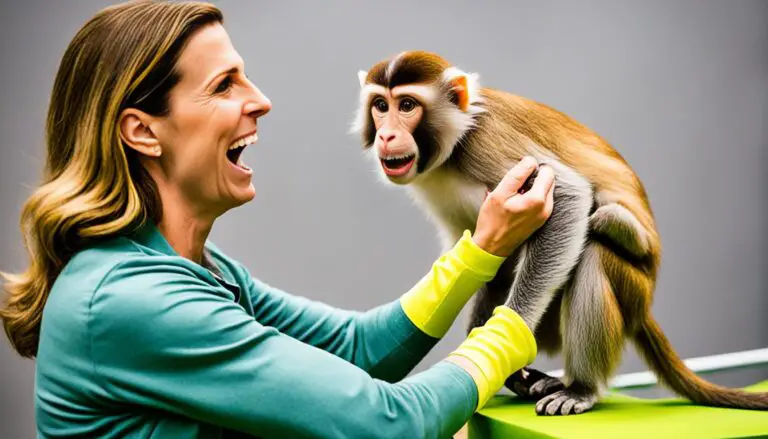Exotic Pet Training Tips – Teach Your Pet New Tricks Today
Exotic pets are becoming more and more popular, and it’s no wonder why.
From snakes to sugar gliders, there are a wide variety of unique and interesting animals to choose from.
One of the most exciting things about owning an exotic pet is teaching them new tricks.
However, teaching a pet a new trick can be a challenge, especially if they are not a typical household pet.
In this article, we will explore the best methods for teaching your exotic pet new tricks.
Key takeaways:
- Training an exotic pet requires patience, consistency, and a positive approach.
- Basic training techniques such as clicker training and positive reinforcement can be used to teach your pet new tricks.
- Before attempting advanced training, make sure your pet has mastered basic commands and has the physical ability to perform the desired trick.
- Avoid punishing your pet for not learning quickly and always provide proper care for your pet.
- Troubleshoot training issues by addressing stubbornness, fear, anxiety, and distractions.
- Seeking professional help can be a useful option for challenging cases.
Understanding Your Exotic Pet
Before you start training your exotic pet, it’s important to take the time to understand their behavior and natural instincts.
Different exotic pets have unique personalities and may respond differently to training methods.
Take the time to observe your pet and learn what motivates them.
Some pets may respond well to food rewards, while others may be more motivated by playtime or affection.
Knowing what your pet enjoys can help you tailor your training approach to their individual needs.
Additionally, it’s important to understand your pet’s natural instincts. For example, snakes may be more likely to respond to visual cues, while birds may be more responsive to sound.
By understanding your pet’s instincts, you can work with them to create a training plan that is both effective and enjoyable.
Building a Strong Relationship with Your Pet
Establishing a strong bond with your exotic pet is key to successful training.
Take the time to build trust with your pet through gentle handling, positive reinforcement, and regular interaction.
Creating a positive environment for your pet can also help build trust and make training sessions more enjoyable for both you and your pet.
Bonding activities, such as playtime, grooming, and cuddling, can also help strengthen your relationship with your pet.
By establishing a strong bond, you can create a foundation for successful training and an overall happier and healthier relationship with your pet.
Basic Training Techniques
Here are four really effective basic training methods that you can try on your exotic pet:
1. Positive reinforcement training
When it comes to training your exotic pet, positive reinforcement is one of the most effective methods.
Positive reinforcement involves rewarding your pet for desired behavior, such as following a command or performing a trick.
Rewards can include treats, praise, or playtime.
2. Clicker training
Clicker training is another effective method for training your exotic pet.
Clicker training involves using a small device that makes a clicking sound to mark the desired behavior.
When your pet performs the desired behavior, you click the device and then reward your pet.
3. Utilizing a rewards-based training
Shaping behavior through rewards is another technique that can be used to train your exotic pet.
This involves breaking down a complex behavior into smaller steps and rewarding your pet for each step.
Over time, your pet will learn to perform the behavior in its entirety.
Don’t forget to be consistent
Consistency is key when it comes to training your pet.
Make sure to train your pet regularly and use the same commands and methods each time.
By providing consistent training, you can help your pet learn faster and avoid confusion.
Teaching Specific Tricks
Teaching your exotic pet specific tricks can be a fun and rewarding experience.
Here are some basic tricks that you can start with:
1. Teaching your pet to come when called
This is a simple trick that can be taught using positive reinforcement. Start by saying your pet’s name followed by the command “come.”
When your pet comes to you, reward them with a treat or praise.
Over time, your pet will learn to associate the command “come” with a positive reward.
2. Teaching your pet to shake or give paw
Start by holding a treat in your hand and saying the command “shake” or “give paw.”
When your pet reaches out their paw, reward them with the treat.
Over time, your pet will learn to associate the command with the action.
3. Teaching your pet to roll over
Start by having your pet lie down on their side.
Hold a treat in front of their nose and slowly move it towards their shoulder.
As your pet follows the treat, they will roll over onto their back. Reward them with the treat and praise.
Over time, your pet will learn to perform the behavior on command.
4. Teaching your pet to play dead
Start by having your pet lie down on their side.
Hold a treat in front of their nose and slowly move it towards the ground.
As your pet follows the treat, they will roll onto their back and play dead. Reward them with the treat and praise.
Over time, your pet will learn to associate the command “play dead” with the action.
Advanced Training Techniques
Once your exotic pet has mastered the basics, you can move on to more advanced training techniques.
Here are some tricks you can teach your pet:
1. Teaching Your Pet to Fetch
Fetching is a fun game that many pets enjoy.
Start by placing a toy in front of your pet and encouraging them to pick it up with their mouth.
Once they have the toy, call them back to you and reward them with a treat and praise.
Gradually increase the distance your pet needs to travel to retrieve the toy and continue to reinforce the behavior with rewards.
2. Teaching Your Pet to Climb or Crawl
If your pet is a climber or a crawler, you can teach them to navigate obstacles.
Start by setting up a simple obstacle course using boxes or other household objects.
Encourage your pet to climb or crawl through the course and reward them for completing each step.
Over time, you can increase the difficulty of the course to challenge your pet and improve their skills.
3. Teaching Your Pet to Balance Objects
Balancing objects on your pet’s head or nose is a fun trick that can impress your friends and family.
Start by placing a lightweight object, such as a toy or a treat, on your pet’s head while they are sitting or lying down.
Encourage them to balance the object and reward them with a treat and praise.
Gradually increase the weight and size of the object to improve your pet’s balance.
4. Teaching Your Pet to Open and Close Doors
If your pet is strong enough, you can teach them to open and close doors.
Start by attaching a rope or a cloth to the door handle and encouraging your pet to pull on it.
Reward them for their efforts and gradually increase the weight of the object attached to the rope to build their strength.
5. Teaching Your Pet to Skateboard or Surf
For the adventurous pet, skateboarding or surfing can be a fun trick to learn.
Start by introducing your pet to the skateboard or surfboard and allowing them to sniff and investigate it.
Encourage your pet to step on the board and reward them for their efforts.
Gradually increase the amount of time your pet spends on the board and reinforce the behavior with treats and praise.
Common Mistakes to Avoid
While training your exotic pet, there are some common mistakes you should avoid:
1. Punishing Your Pet for Not Learning Quickly
Training takes time and patience.
Punishing your pet for not learning quickly can be counterproductive and damage your relationship with your pet.
Instead, focus on positive reinforcement and be patient with your pet as they learn.
2. Failing to Understand Your Pet’s Limitations
Every pet has their own limitations and abilities.
It’s important to understand your pet’s behavior and instincts and tailor your training approach to their needs.
3. Skipping Basic Training Steps
Basic training steps are the foundation for more advanced tricks and behaviors.
Skipping these steps can result in confusion and frustration for your pet.
Make sure to establish a strong foundation before moving on to more advanced techniques.
4. Neglecting to Provide Proper Care for Your Pet
Proper care and attention are crucial for your pet’s health and well-being.
Neglecting to provide proper care can lead to stress and anxiety, which can affect your pet’s ability to learn and perform tricks.
Troubleshooting Training Issues
Even with the best intentions, training your exotic pet can sometimes be challenging.
Here are some common issues you may encounter and how to overcome them:
1. Dealing with stubbornness or lack of motivation
Some exotic pets can be stubborn or uninterested in learning new tricks.
To combat this, it’s important to find a reward that motivates them.
This could be a favorite treat, toy, or even praise and affection from their owner.
It’s also important to break down the trick into smaller, more manageable steps and reward your pet for each successful step.
This will help build momentum and encourage your pet to keep trying.
2. Overcoming fear or anxiety
Exotic pets can also be easily frightened or anxious, which can make training a challenge.
It’s important to start slow and make sure your pet is comfortable with each step before moving on to the next one.
If your pet shows signs of fear or anxiety, it’s best to take a break and try again later.
Over time, your pet will become more comfortable with the training process and be more willing to try new things.
3. Working through distractions
Distractions can be a major hurdle when training exotic pets.
It’s important to start training in a quiet, distraction-free environment and gradually introduce distractions as your pet becomes more skilled.
For example, if you’re teaching your pet to fetch, start in a quiet room and gradually add more people or objects to the environment. This will help your pet learn to focus and concentrate even in distracting situations.
4. Seeking professional help when necessary
If you’ve tried everything and are still having difficulty training your exotic pet, it may be time to seek professional help.
Look for a trainer or behaviorist who has experience working with your specific type of pet.
They can help diagnose any underlying issues and develop a customized training plan to help your pet learn new tricks.
Conclusion
Teaching your exotic pet new tricks can be a fun and rewarding experience for both you and your pet.
By starting with basic training techniques, gradually progressing to more advanced tricks, and troubleshooting any issues that arise, you can help your pet learn new skills and build a stronger bond with you.
With patience, persistence, and a little creativity, the possibilities for what you can teach your exotic pet are endless.
FAQs
Can all exotic pets be trained?
While many exotic pets can be trained, it’s important to research your specific pet to understand their behavior and instincts.
Some pets may be more trainable than others.
What is the best way to establish a bond with my exotic pet?
Gentle handling, positive reinforcement, and regular interaction can help build trust and establish a strong bond with your exotic pet.
What should I do if my exotic pet is not responding to training?
Be patient and consider adjusting your training approach.
Some pets may require a different method or may need more time to learn.
How long does it typically take to teach a pet a new trick?
The amount of time it takes to teach a new trick can vary depending on the complexity of the trick and your pet’s individual abilities.
It may take several days or even weeks to see progress.
Are there any safety considerations when training exotic pets?
Yes, it’s important to consider the safety of both you and your pet when training.
Always use positive reinforcement and avoid using force or punishment.
Additionally, make sure to provide a safe and controlled environment for training sessions.
Can any exotic pet be taught tricks?
Yes, with the right training and patience, almost any pet can be taught tricks.
What kind of treats should I use for training my pet?
Use treats that are safe and healthy for your pet, such as small pieces of fruits or vegetables or specially-made pet treats.
Can you teach an older exotic pet new tricks?
Yes, older pets can still learn new tricks with the right training and patience.
Is it possible to teach my exotic pet too many tricks?
While it’s always great to teach your pet new things, it’s important to ensure that you are not overwhelming them or neglecting their basic needs in the process.
Be sure to balance training with proper care and attention for your pet.
Peter Stones is the founder of Exotic Pets Place, the leading online resource for exotic pet care information.
With over 10 years of hands-on exotic pet ownership experience, he is deeply passionate about sharing his expertise to help others properly care for their unusual pets.
When he's not writing extensively researched articles or connecting with fellow exotic pet enthusiasts worldwide, you can find Peter at home tending to his own beloved menagerie of exotic animals.







